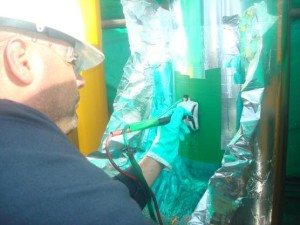Labeled the world’s most expensive oil field by Business Insider, the Kashagan oil field was one of the largest oil discoveries of the last 40 years. Estimated to hold 16 billion barrels of oil, it is located in the Caspian Sea in Kazakhstan. The field owned by Eni, Exxon, Shell, Total and the Kazakh Government; is operated by, joint-venture, North Caspian Operating Company.

Currently producing 160,000 barrels per day (bpd), it is expected to reach its goal of 370,000 bpd by the end of 2017. But it wasn’t easy getting here. Plagued by problems, the biggest setback came in 2013 when a key pipeline connecting the on-shore processing facility corroded, forcing a full-shutdown. While this may have delayed the project, it also highlighted major areas of concerns and opportunities for preventative maintenance. The Caspian Sea is known for it’s harsh winters and poisonous hydrogen sulfide gas (the cause the pipeline corrosion).
Many surface finishing techniques are used in oil and gas industry for corrosion, anti-galling and wear. The portability of the brush plating process makes it ideal for off-shore rigs, and the unexpected repairs that may be needed. For example, significant damage was caused to the crown mounted compensator (CMC) cylinder when lightning struck the ENSCO rig. The impact of the lightning strike caused a substantial gouge, the size of a coin, on the CMC cylinder. Without immediate repairs the damage could cause the cylinder seals to leak, resulting in hydraulic fluid loss and the threat of significant lost production. Using SIFCO’s AeroNikl® 7280 for corrosion protection, and Cobalt 2043 to cap the repair for hardness to protect against surface wear, the on-site repair was completed in 24 hours.
SIFCO ASC has also received approved vendor status from Tenaris and VAM, the leading licensors for oil field thread design. This approved status qualifies SIFCO ASC to train operators, worldwide, to selectively apply copper onto premium threaded connections.
By learning from the experience and preventing future failures, the field is now (while behind schedule) fully operational. To date, the NCOC estimated “it’s produced more than 7 million barrels of crude oil and an ultra-light form of oil called condensate since production […] resumed in late 2016,” according to United Press International, Inc.
Read the original articles on BusinessInsider.com and UPI.com.

 Chinese (Simplified)
Chinese (Simplified)  English
English  French
French  German
German  Spanish
Spanish  Swedish
Swedish 